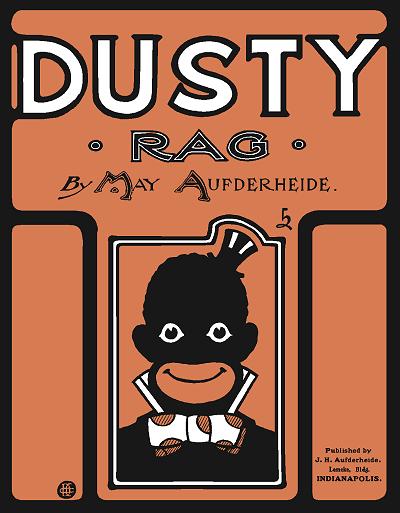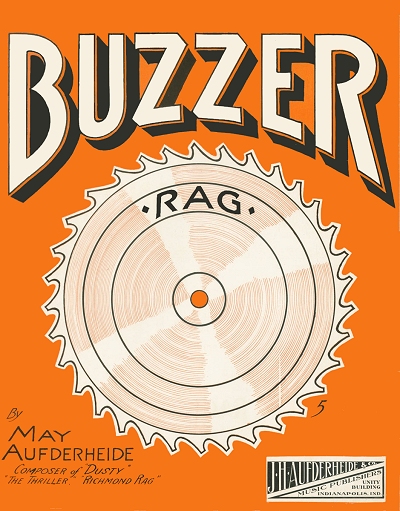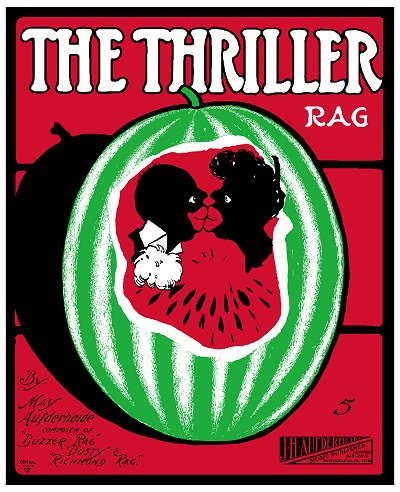|
May Frances Aufderheide Kaufman (May 21, 1888 to September 1, 1972) | |
 Compositions Compositions
| |
|
1908
Dusty RagThe Richmond Rag 1909
The Thriller!Buzzer Rag I'll Pledge My Heart to You 1910
Blue Ribbon RagA Totally Different Rag A Totally Different Rag Song [1] In Bamboo Land [1] My Girl of the Golden Days [1] 1911
Novelty RagPompeian Waltzes |
1911 (Cont)
I Want a Patriotic Girl [2]Drifting in Dreams With You [3] You and Me in the Summertime [3] I Want a Real Lovin' Man [4] Pelham Waltzes 1912
Dusty Rag Song [5]
1. w/Earle C. Jones
2. w/Bobby Jones 3. w/Rudolph Aufderheide 4. w/Paul Pratt 5. w/J. Will Callahan |
May Frances Aufderheide was one of two siblings born into a somewhat musical family in Indianapolis, Indiana, to John Henry Aufderheide, a capable violinist who chose a career in banking, and Lucy M. Deel. Some sources report varying years of birth, but the 1900 census is fairly specific with an 1888 date, which also aligns well with the ages given in 1920 and 1930. John's sister May Kolmer was a talented pianist who had played public concerts with the Indianapolis Symphony, later teaching at the Metropolitan School of Music.
John's sister May Kolmer was a talented pianist who had played public concerts with the Indianapolis Symphony, later teaching at the Metropolitan School of Music.
 John's sister May Kolmer was a talented pianist who had played public concerts with the Indianapolis Symphony, later teaching at the Metropolitan School of Music.
John's sister May Kolmer was a talented pianist who had played public concerts with the Indianapolis Symphony, later teaching at the Metropolitan School of Music.May Frances took classical piano lessons from her aunt while in her teens, but always felt a lure to ragtime and popular music. Her father remained somewhat dedicated to music, even while running his growing small loan business. With some of his profits he became a patron of musical arts in Indianapolis. It was likely when she was attending Pelham Manor finishing school in the east that May set some rags down to paper. When she returned around early 1908 May was determined to have one of her pieces published.
With the help of a young itinerant Indianapolis sign painter named Cecil Duane Crabb, who drew a cover and arranged the printing, and one of his friends, future composer Paul Pratt who did the musical arrangement and engraving, Dusty Rag was released. Crabb did not have the capability of distributing the piece beyond the boundaries of urban Indianapolis, and while May was touring Europe (as all refined girls from well-to-do families must), Dusty Rag was initially gathering dust in local music stores.
Upon May's return from Europe in 1908 she married young architect Thomas Millikan Kaufman on March 25, and they settled to the eastern part of the state in Richmond, Indiana, by year's end. Her musical desire must have been compounded when her cousin Frieda Aufderheide had The Flyer Rag published. May's father saw that she was determined to compose, and spurred on in part by her ability to publish a rag on her own and by the slowly growing sales of Dusty Rag, he formed J.H. Aufderheide & Company to publish her works, perhaps also as a wedding present. John bought the Dusty Rag copyright and reissued it under his label along with her Richmond Rag, named for her new locale.
and spurred on in part by her ability to publish a rag on her own and by the slowly growing sales of Dusty Rag, he formed J.H. Aufderheide & Company to publish her works, perhaps also as a wedding present. John bought the Dusty Rag copyright and reissued it under his label along with her Richmond Rag, named for her new locale.
 and spurred on in part by her ability to publish a rag on her own and by the slowly growing sales of Dusty Rag, he formed J.H. Aufderheide & Company to publish her works, perhaps also as a wedding present. John bought the Dusty Rag copyright and reissued it under his label along with her Richmond Rag, named for her new locale.
and spurred on in part by her ability to publish a rag on her own and by the slowly growing sales of Dusty Rag, he formed J.H. Aufderheide & Company to publish her works, perhaps also as a wedding present. John bought the Dusty Rag copyright and reissued it under his label along with her Richmond Rag, named for her new locale.Hiring Paul Pratt to manage the enterprise, John's company was successful enough to garner column space in the American Musician and Art Journal in the summer of 1909. He also placed a large ad in the journal with a picture of May, informing the readers to "keep your eye (and ears)" on her. It touted May Frances as a composer with a future, noted her two pieces that were currently in demand, and told of two more that were sure to be hits. They were Buzzer Rag and The Thriller, the latter which would become her best known work.
The Kaufmans were honored by May's parents at an extravagant society reception held in Indianapolis on January 14, 1910, so Thomas was certainly a welcome addition to the family. The 1910 census taken in Indianapolis had John listed as a loan broker, and Rudolph working as a clerk in his father's Commonwealth Loan office. Over in Richmond, Thomas was listed as an architect, and May had no occupation indicated.
The Aufderheide company published other works not only by Paul Pratt, but two of May's acquaintances, Gladys Yelvington and Julia Lee Niebergall. May and her husband moved back to Indianapolis in 1911 or 1912 in part because of his inability to retain work in the architecture field, and to live in a place where he had better income prospects. It was during that time that she finished her last published piano rag, Novelty Rag. The only issue from the Aufderheide company in 1912 was a song version of Dusty Rag which did not fare well. It also marked the end of May's composing career.
It was during that time that she finished her last published piano rag, Novelty Rag. The only issue from the Aufderheide company in 1912 was a song version of Dusty Rag which did not fare well. It also marked the end of May's composing career.
 It was during that time that she finished her last published piano rag, Novelty Rag. The only issue from the Aufderheide company in 1912 was a song version of Dusty Rag which did not fare well. It also marked the end of May's composing career.
It was during that time that she finished her last published piano rag, Novelty Rag. The only issue from the Aufderheide company in 1912 was a song version of Dusty Rag which did not fare well. It also marked the end of May's composing career.Thomas Kaufman, who had not measured up as an architect either in Richmond or Indianapolis, eventually ended up reluctantly working for John in the banking business as a broker around 1916. His marriage to May reportedly remained strained in spite of abundant financial security. His 1918 draft record showed Thomas working in land and investments. In the 1920 enumeration May was shown as having no occupation, not even teaching music, while Thomas was shown as a broker of stocks and bonds. John Aufderheide Kaufman was born on January 1, 1922, but died the next day of pneumonia, and was interred in Crown Hill Cemetery. Soon after this the couple adopted a daughter, Lucy Kaufman, who had been born on January 12, 1922.
The 1930 census showed Thomas to be an investment broker during a difficult time for that occupation. By that time May was reportedly not even playing the piano at home anymore. The family was living in the same place in Washington, Indiana, as of the 1940 enumeration, with Thomas now the Vice President of Commonwealth. In 1941, following John Aufderheide's death, Thomas became the chairman of the board of directors for Commonwealth. The family eventually moved to Pasadena, California around 1947, residing on the grounds of the elegant Huntington Sheraton Hotel. The 1950 census showed them there with no occupation. In the mid-1950s Mrs. Kaufman became wheelchair bound due to arthritis and other issues, and remained so until her death.
Lucy passed on in Daytona Beach, Florida, on February 18, 1959, followed by Thomas, who died in December of 1960 in Pasadena. May remained there another 12 years until her death, but was also the victim of several strokes in the interim. She died in Pasadena at age 94 on the cusp of the ragtime revival that would bring many of her works and her story to a new audience, thanks to musicians such as Max Morath and John Edward Hasse. To this day, May Aufderheide's rags remain among the most popular of those composed by women during the ragtime era.